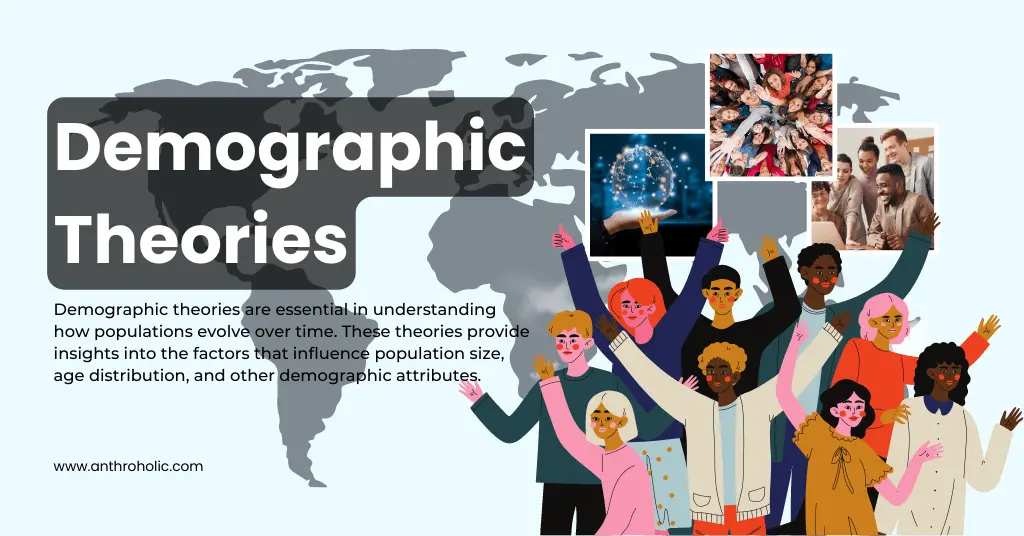AI Answer Evaluation Platform Live Now. Try Free Answer Evaluation Now
Demographic Theories: Biological, Social & Cultural
Demographic theories are essential in understanding how populations evolve over time. These theories provide insights into the factors that influence population size, age distribution, and other demographic attributes.

Biological Perspectives
Malthusian Theory of Population (Malthus, 1798)
One of the earliest biological theories of population was proposed by Thomas Malthus in 1798. Malthus suggested that populations grow geometrically, while food production grows arithmetically. He argued that populations would always outstrip their resources, leading to famine, disease, and other calamities (Malthus, 1798). This theory has been criticized for its deterministic approach, as it fails to consider technological advancements and social factors that have since proven to be critical in mitigating population growth.
Demographic Transition Theory (Notestein, 1945)
The demographic transition theory was first proposed by Frank W. Notestein in 1945. This theory posits that populations transition through four stages, characterized by different birth and death rates (Notestein, 1945). The stages are:
- Pre-transition: High birth and death rates
- Early transition: High birth rate, declining death rate
- Late transition: Declining birth and death rates
- Post-transition: Low birth and death rates
This theory has been widely used to understand and predict population trends, particularly in the context of economic development and modernization (Caldwell, 2006).
Social Perspectives
Easterlin’s Relative Income Hypothesis (Easterlin, 1973)
Richard Easterlin proposed the relative income hypothesis in 1973 to explain fertility patterns in developed countries. According to this theory, couples’ fertility decisions are influenced by their relative income and aspirations, which are shaped by their social environment (Easterlin, 1973). Couples with higher relative income and social status are more likely to have fewer children, as they prioritize investment in quality over quantity.
Second Demographic Transition Theory (Lesthaeghe & van de Kaa, 1986)
Building on the demographic transition theory, Ron Lesthaeghe and Dirk van de Kaa introduced the concept of the second demographic transition in 1986. This theory argues that social and cultural changes, such as increased individualism and the erosion of traditional family values, have led to further declines in fertility rates and the rise of new family forms (Lesthaeghe & van de Kaa, 1986). The second demographic transition theory helps explain the demographic changes observed in many developed countries since the 1960s.
Cultural Perspectives
Caldwell’s Theory of Intergenerational Wealth Flows (Caldwell, 1976)
John C. Caldwell’s theory of intergenerational wealth flows emphasizes the role of cultural factors in shaping fertility patterns. According to this theory, fertility decisions are influenced by the flow of wealth and resources between generations (Caldwell, 1976). In traditional societies, high fertility is often advantageous, as children contribute to family income and provide support to their parents in old age. However, in modern societies, the flow of wealth is often reversed, with parents investing heavily in their children’s education and well-being. This shift in wealth flows has contributed to declining fertility rates in many countries.
Culture and Reproduction: The Low Fertility Paradox (Morgan & King, 2001)
In their study of low fertility in developed countries, S. Philip Morgan and Rosalind B. King proposed the low fertility paradox, which highlights the role of cultural factors in shaping fertility behavior. They observed that despite widespread access to contraceptives and a high prevalence of family planning, fertility rates in some countries remained stubbornly low (Morgan & King, 2001). The low fertility paradox suggests that cultural factors, such as attitudes towards gender roles, work-family balance, and social norms around childbearing, play a significant role in shaping fertility patterns.
Conclusion
Demographic theories encompass a range of biological, social, and cultural perspectives that help us understand and predict population trends. From Malthus’ early warnings about population growth to more recent theories on the second demographic transition and the low fertility paradox, these theories have provided valuable insights into the complex interplay of factors that shape population dynamics. As the world’s population continues to evolve, demographic theories will remain critical tools for understanding and addressing the challenges and opportunities that lie ahead.
References
- Caldwell, J. C. (1976). Toward a restatement of demographic transition theory. Population and Development Review, 2(3/4), 321-366.
- Caldwell, J. C. (2006). Demographic transition theory. Springer.
- Easterlin, R. A. (1973). Relative economic status and the American fertility swing. In E. B. Sheldon (Ed.), Family economic behavior: Problems and prospects (pp. 170-223). Lippincott.
- Lesthaeghe, R., & van de Kaa, D. J. (1986). Twee demografische transities? [Two demographic transitions?]. In R. Lesthaeghe & D. J. van de Kaa (Eds.), Bevolking: Groei en krimp [Population: Growth and decline] (pp. 9-24). Van Loghum Slaterus.
- Malthus, T. R. (1798). An essay on the principle of population. J. Johnson.
- Morgan, S. P., & King, R. B. (2001). Why have children in the 21st century? Biological predisposition, social coercion, rational choice. European Journal of Population, 17(1), 3-20.
- Notestein, F. W. (1945). Population – The long view. In T. W. Schultz (Ed.), Food for the world (pp. 36-57). University of Chicago Press.



